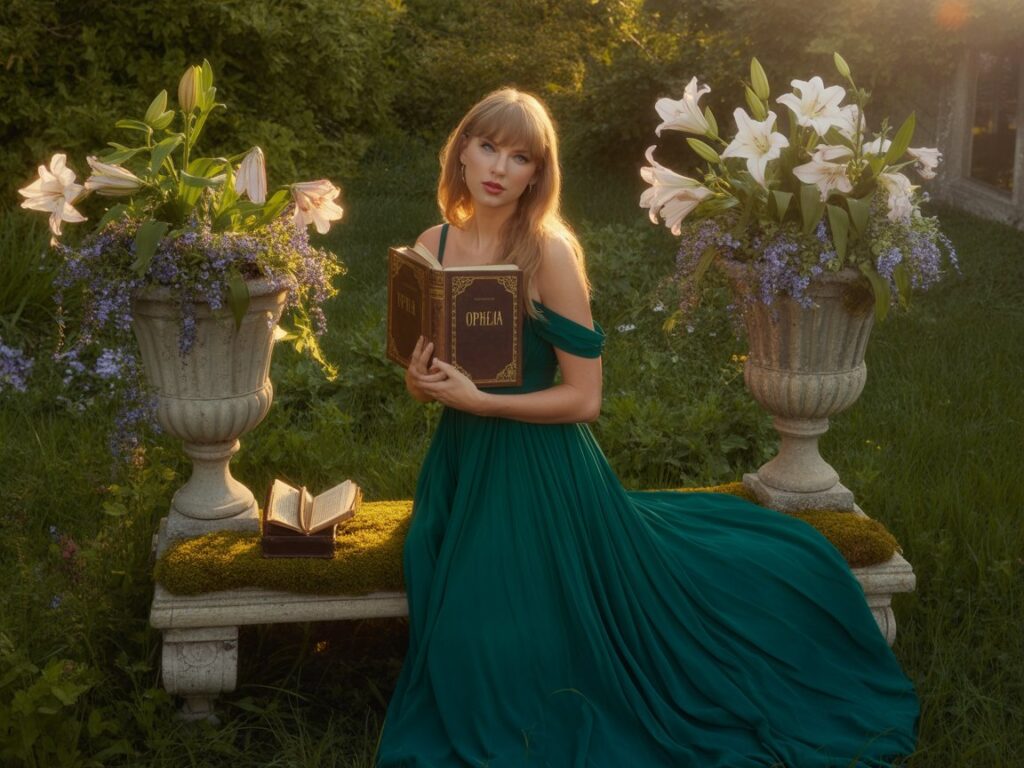Taylor Swift Rewrites Ophelia: This long-form piece pulls together the full context behind the buzz you’ve been searching for — from “The Fate of Ophelia” and related tracks (Opalite, Wi$h Li$t / Wish List, Honey, Wood) to the Shakespearean roots of Ophelia, Travis Kelce links, where to hear the songs, and how the podcast world (New Heights) and culture press amplified the conversation.
Why this matters right now
Taylor Swift Rewrites Ophelia: Taylor Swift released her 12th studio album The Life of a Showgirl on Oct 3, 2025, and the opening track — “The Fate of Ophelia” — immediately became the center of conversation: literary reference, personal storytelling, and high-profile relationship all in one. Media outlets and fans raced to interpret lyrics, spot references to Travis Kelce, and compare the song’s Ophelia to Shakespeare’s tragic character. That combination of pop culture + classic literature + celebrity life fuels huge search interest and social sharing.
1) The anchor: who is Ophelia (short primer)
Ophelia is a canonical character from William Shakespeare’s Hamlet (c. 1599–1601). In the play she is the daughter of Polonius and sister of Laertes; her relationship with Hamlet and the events around her family push her into grief-stricken madness and ultimately to her death by drowning — a symbol-rich episode that artists have reinterpreted for centuries. If you want a concise, reputable source: modern references and educational sites (and Shakespeare editions) outline Ophelia’s arc as an archetype of fragility, obedience, and tragic loss.
Reader prompt: have you seen Millais’s famous painting of Ophelia? It’s a primary visual many pop culture writers reference when the image of “drowning in a stream” appears in modern songs or videos. (You can find the painting and Tate commentary via the Time/press writeups linked below.)
2) What The Fate of Ophelia actually says (the plain reading)
In The Fate of Ophelia, Taylor juxtaposes Shakespeare’s lonely, tragic heroine with a modern “rescue” story: lines in the song and the album artwork reverse the drowning image — instead of disappearing beneath the water, the singer’s face/identity remains above it. The lyrics explicitly say she was “saved” from Ophelia’s fate and reference being dug “out of my grave” and “no longer drowning,” which critics read as her reclaiming agency and crediting a present partner for emotional rescue. This reading is widely reported in cultural coverage of the album release.
Why the comparison resonates: Ophelia’s tragedy is about losing voice and autonomy; Taylor repurposes that image to underline a narrative of regained agency and protection — classic Swift storytelling technique: anchor a modern moment in shared cultural imagery.

3) The Travis Kelce connection, and why outlets think it’s real
Many journalists and fans flag lyrical details (“pledge allegiance to your hands, your team, your vibes” and references to megaphones and teams) that read as nods to Travis Kelce (NFL star and Taylor’s fiancé). That line of interpretation is reinforced by their relationship timeline, public appearances, and the fact that Taylor has previously used literary and cinematic references to frame personal moments in song. Reputable coverage (Time, Elle, Cosmopolitan) foregrounds this reading while noting that artistic interpretation is never a literal confirmation — but that the clues are consistent with a public love story.
Interactive note: If you’re tracking lyric clues across songs, try a simple spreadsheet: song → suspicious lyric → possible real-life referent → supporting evidence (photo/date/interview). It’s the method many music journalists use to avoid overclaiming.
4) What about Opalite, Wi$h Li$t / Wish List, Honey, Wood, Wishlist — the rest of the buzz
- Opalite: Reporters and pop commentators interpret this track as another love-centered cut from the album that uses gemstone imagery (opal/opalite) to symbolize a new light or clarity in the singer’s life. Coverage from mainstream outlets frames it as a warm, post-relationship-recovery song with inside references fans connect to Kelce.
- Wi$h Li$t / Wish List / Wishlist: Stylized spellings surfaced online and in press writeups; across the coverage, Wi$h Li$t is described as a domestic, future-looking track imagining family life, a driveway with a basketball hoop, settling-down imagery and privacy from the public — concrete wishes laid out in a way that feels like a private note made public.
- Honey: Press reads this as a companion track that uses terms of endearment to reclaim language that was once weaponized against the singer. Streaming pages and early reviews list the track on the album and show it circulating across platforms.
- Wood / Wood lyrics / Taylor Swift wood: A recurring rumor tag: “Wood” appeared in fan lists and early article mentions as a track or lyric motif tied to “home” imagery; treat it as part of the album’s domestic tableau unless confirmed directly on official tracklists. (Always confirm via official album metadata from streaming services and Taylor’s official channels.)
Practical tip: when you search for lyrics or unreleased track names, use official streaming pages (Spotify, Apple Music), the artist’s website, or major outlets — those sources reduce the risk of quoting misheard or fan-made lyrics.

5) Timeline of the viral buzz (step-by-step)
- Pre-release clues: Taylor’s stage visuals and prior promotional imagery hinted at literary references; fans began theorizing months prior.
- Oct 3, 2025 — album drop: Media outlets published track analyses and lyric breakdowns within hours; fan threads amplified lines referencing Ophelia.
- Podcasts & talk shows: Sports and culture podcasts (including New Heights, run by Jason & Travis Kelce) were discussed as contexts where the public learned more about the couple; mentions on these shows fed back into social media conversation.
- Streaming platforms & playlists: The album immediately appeared on major platforms (Spotify, Apple Music) and global editorial playlists, accelerating exposure to tracks like “The Fate of Ophelia,” “Opalite,” and “Wi$h Li$t.”
6) How journalists and literary critics read the Shakespeare tie-in
Mainstream culture writers note that Taylor isn’t using Ophelia to retell Hamlet — she’s reframing the symbol. Instead of allowing Ophelia to represent helplessness, Taylor flips the image: “saved” rather than drowned. Critics see this approach as consistent with her history of interweaving classic sources into pop (e.g., earlier references to Romeo and Juliet). The result: accessible pop music that invites deeper literary conversation.
7) How to responsibly read and share lyrics online (do’s & don’ts)
Do
- Check official album pages on Spotify/Apple Music and Taylor Swift’s official site for tracklists and credits.
- Use reputable culture outlets (Time, Elle, Cosmopolitan) for early, verified lyrical readings.
- Attribute speculation clearly as fan/press interpretation, not hard fact.
Don’t
- Repost unattributed fan lyric screenshots or transcriptions without confirmation — misheard lines spread quickly.
- Treat every stylized fan tag (e.g., wi$h li$t) as canonical — verify against official track titles.

Verified listening + fact-check checklist (step-by-step for readers)
- Open Taylor Swift’s official artist page on Spotify or Apple Music and confirm the album The Life of a Showgirl (released Oct 3, 2025).
- Read lyric breakdowns from major outlets (Time, Elle) for contextual analysis that cites lines and artwork.
- Cross-check any strong claims (e.g., references to personal life) with reliable reportage — reputable outlets will caveat opinion vs. fact.
- Listen to relevant podcast episodes (New Heights) to find any first-hand references or contexts from the parties involved.
What this all means for fandom and culture
Taylor’s use of Ophelia is an example of how pop stars repurpose classical tropes to narrate present-day lives. It also shows how quickly cultural meaning forms in a media ecosystem: lyric drops → press analysis → podcast context → fan threads → viral memes. That loop shapes the public’s understanding of the song faster than anything else.
Engagement idea: create a short thread or newsletter section titled “Then vs. Now” comparing Ophelia (Shakespeare) with Taylor’s reimagined showgirl image — readers love side-by-side cultural comparisons.
Final notes, ethics & copyright
- The lyric quotes and interpretations above are drawn from reputable coverage and the official album release. For full, verbatim lyrics consult the album on authorized platforms or Taylor Swift’s official channels.
Valid external links
- TIME — The Meaning Behind ‘Ophelia’ on Taylor Swift’s The Life of a Showgirl (Oct 3, 2025). https://time.com/7322789/taylor-swift-ophelia-life-of-a-showgirl/ (TIME)
- Spotify — Taylor Swift album/track pages (search the album The Life of a Showgirl on Spotify for official streaming & credits). https://open.spotify.com/ (search within for the album/track). (Spotify)
Disclaimer
This article is for informational and cultural commentary purposes only. All song lyrics, album credits, and streaming assets referenced are property of their respective copyright holders. TrenBuzz.com and this author do not claim ownership of quoted lyrics; readers should consult official platforms for verified lyrics and credits. This post relies on reporting from established outlets; interpretations of lyrics reflect media readings and fan discussion as of Oct 3, 2025. Images used in this article are royalty‑free or licensed for commercial use and are provided here for illustrative purposes.
